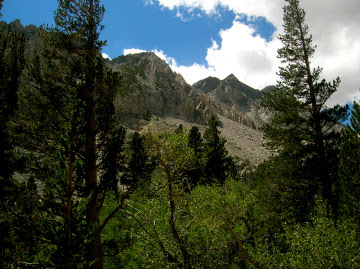
Today's first goal:
The notch in the crest
The third day of a backpacking week is often one of the most fun. The body has begun to adjust to both altitude and pack. By this time, the party is well into the wilderness, and the opportunity presents itself to leave camp assembled, ditch the backpacks in favor of a day pack, and do a day hike from camp. This year, the day hike provided some of the best entomology of the trip.

Desolation Lake

Camp Desolation
Out trip would lead us from Camp Desolation, above the shores of Desolation Lake, up to the crest of the Sierras on the north slopes of Mt. Humphreys. The goal was to peek through several of the numerous notched in the crest and have a look down the east slope and into Owens Valley.

Long-lipped Tiger Beetle
Cicindela longilabris perviridis
The breezy day began with great insects almost immediately. About a quarter of a mile uphill from camp we began encounering tiger beetles. It was so breezy that it was possible to creep up on them and take photographs. They are long-lipped tiger beetles (
Cicindela longilabris), and the green form us characteristic of high elevations in the Sierras and Cascades. I had been hoping to see it on this trip, and we encountered dozens.

Circotettix maculatus
Orange-winged Grasshopper
Cratypedes neglectus? C. laeteritus? Something else?
We had been seeing lots of grasshoppers on the trip, and I was able to collect three nice species of band-winged grasshoppers on the climb up to the crest. The most common was
Circotettix maculatus. It has black wings and a noisy snapping and crackling flight. My grasshopper guide book describes it as being characteristic of high elevations in California. The second two species are not yet fully identified. One has beautiful orange wings when it flies. It has some characteristics of
Cratypedes laeteritus and some characteristics of
C. neglectus. I’m not sure what to make of it at the moment. The third species has lemon yellow hindwings and beautiful bright blue tibiae. I haven’t yet tried to identify it.
UPDATE: The orange-winged grasshopper is Cratypedes neglectus. The one with yellow hindwings and blue tibiae is Trimerotropis verruculata.
The boulder field

Desolation Beach
Dude, surf's up! (It was very windy by now)
The trail to the crest follows a relatively gentle rise to a boulder-strewn flat area. With increased elevation, better and better views of Humphreys Basin come into view. We were surprised to see a sandy beach on the north shore of Desolattion Lake. Anybody wishing to go to the beach at over 11,000 feet can find the perfect spot there.

Leon on the final push to the first notch

The view into Owens Valley
You would never know from this picture that the wind was about 50 mph here.

Vertical elements and the view eastward
Once the boulder field is traversed, the hard part begins: a very steep climb up a sandy incline to the crest. In our case, the final climb was made more interesting by a strong wind that got more intense the higher we climbed. When we reached the first notch, the wind was blowing at somewhere between 50 and 60 mph.

A particularly rugged peak in the eastern Sierras
The views east from the crest were unlike anything I’ve ever seen before. What my photos can’t convey is the magnitude of the sheer dropoff into the canyons below. Owens Valley is visible in the distance, and the White Mountains beyond that. I have never before felt such a sense of standing on the edge of the world.

Upper Horton Lake
This photo does not capture how dramatic the dropoff is here.
Drop a stone over the edge and the first bounce is about 1,000 feet below.

Interesting stone formation on the ridgeline.
OK, stop it all of you, right now!
We continued north along the ridge until we came to the north edge of Humphreys Basin. From there we were able to peer northward over another divide and see the canyons and lakes of French Creek Valley. The walk home involved crossing more boulder fields than would have been preferable, but the effort was worthwhile. For me, this was the most rewarding day of the trip.

Looking north into French Creek Valley
Labels: Collecting, Hiking, Sierra Nevada























































